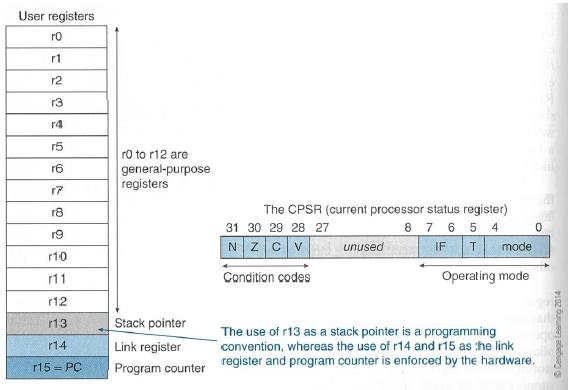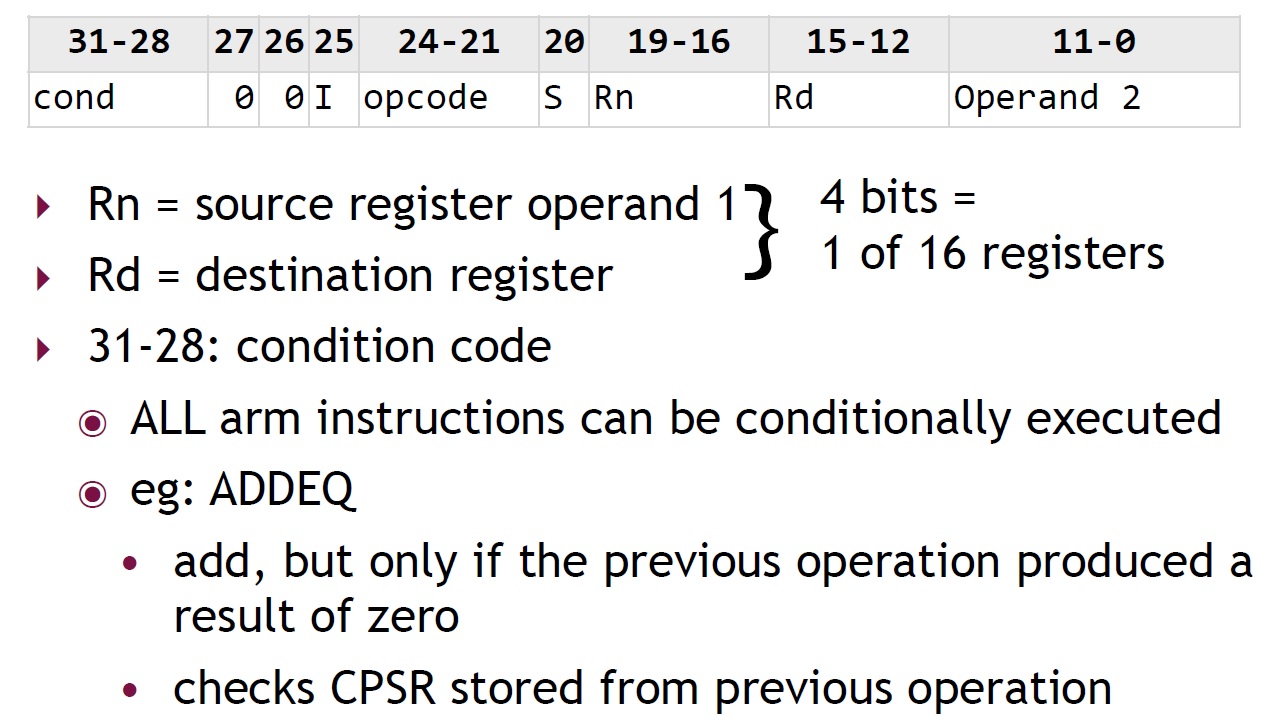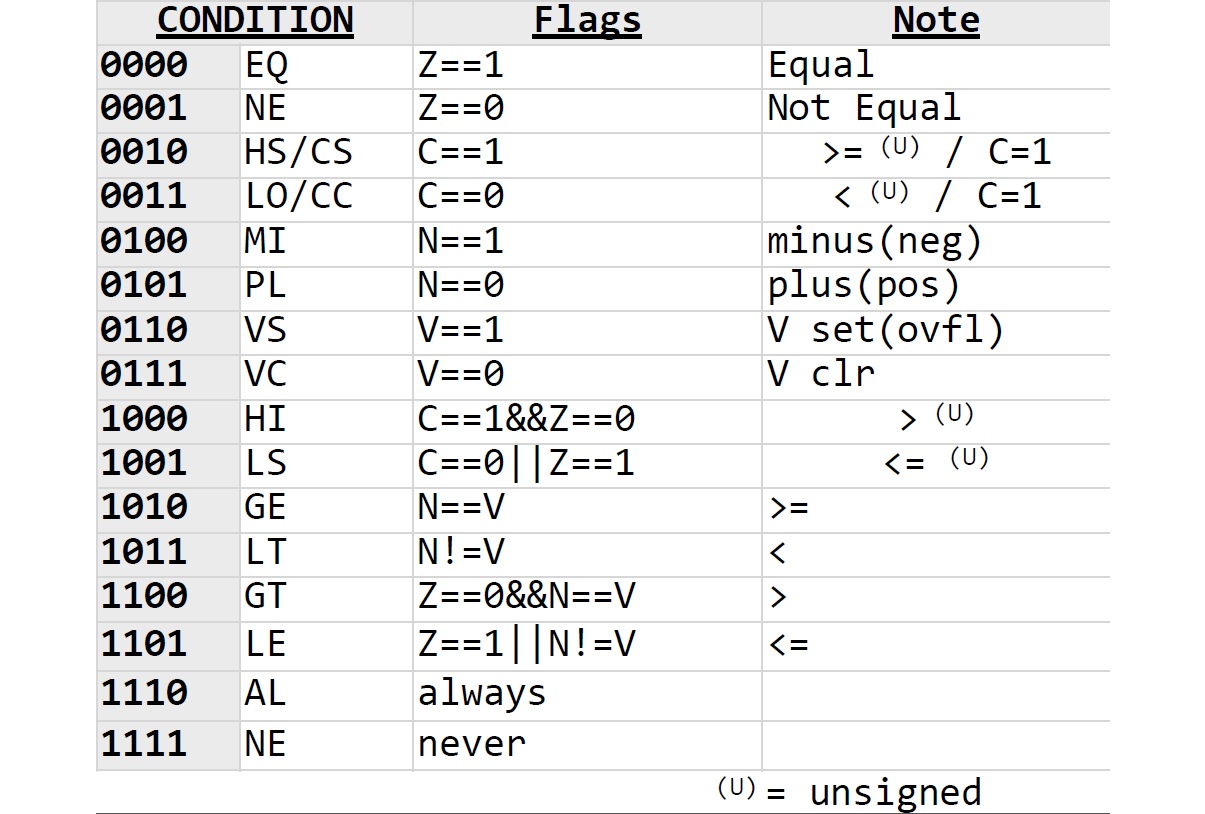ARM's Flow Control Instructions
Objectives
1. To explore ARM branch instructions and implement them in Keil uVision5 2. To investigate how to use strings in Keil uVision5.ARM's Flow Control Instructions modify the default sequential execution. They control the operation of the processor and sequencing of instructions.
Review of ARM Register Set
As mentioned in the previous lab, ARM has 16 programmer-visible registers
and a Current Program Status Register, CPSR.
Here is a picture to show the ARM register set.

R0 to R12 are the general-purpose registers. R13 is reserved for the programmer to use it as the stack pointer. R14 is the link register which stores a subroutine return address. R15 contains the program counter and is accessible by the programmer. Conditonion code flags in CPSR: N - Negative or less than flag Z - Zero flag C - Carry or bowrrow or extendedflag V - Overflow flag The least-significant 8-bit of the CPSR are the control bits of the system. The other bits are reserved.
The Encoding Format for Branch Instructions
Conditional branch instructions contain a signed 24-bit offset that is added to the updated contents of the Program Counter to generate the branch target address. Here is the encoding format for the branch instructions:

Offset is a signed 24-bit number. It is shifted left two-bit positions (all branch targets are aligned word addresses), signed extended to 32 bits, and added to the updated PC to generate the branch target address. The updated PC points to the instruction that is two words (8 bytes) forward from the branch instruction.
ARM instructions are conditionally executed depending on a condition specified
in the instruction. The instruction is executed only if the current state
of the processor condition code flag satisfies the condition
specified in bits b31-b28 of the instruction.
Thus the instructions whose condition does not meet the processor
condition code flag are not executed.
One of the conditions is used to indicate that the
instruction is always executed.
Here is a more detailed description.
All the ARM instructions are conditionally executed depending on a condition specified in the instruction(bits 31-28).
Setting Condition Code Flags
Some instructions, such as Compare, given by CMP R1, R2 which performs the operation R1-R2 have the sole purpose of setting the condition code flags based on the result of the subtraction operation.
The arithmetic and logic instructions affect the condition
code flags only if explicitly specified to do so by a bit in
the OP-code field. This is indicated by appending the
suffix S to the OP-code.
For example, the instruction ADDS R0, R1, R2 sets the condition
code flags. But ADD R0, R1, R2 does not.
- The instruction is executed only if the current state of the
processor condition code flag satisfies the condition
specified in bits b31-b28 of the instruction.
For example: CMP R0, #'A' ; flags are updated according to (R0 - #'A') BEQ VowelCount - The instructions whose condition does not meet the processor condition code flag are not executed.
- One of the conditions is used to indicate that the instruction is always executed.
Branch and Control Instructions
Branch instructions are very useful for selection control and looping control.
Here is a list of the ARM processor's Branch and Control instructions.
------------------------------------------------------------------------ B loopA ; Branch to label loopA unconditioally ------------------------------------------------------------------------ BEQ target ; Conditionally branch to target, when Z = 1 ------------------------------------------------------------------------ BNE AAA ; branch to AAA when Z = 0 ------------------------------------------------------------------------ BMI BBB ; branch to BBB when N = 1 ------------------------------------------------------------------------ BPL CCC ; branch to CCC when N = 0 ------------------------------------------------------------------------ BLT labelAA ; Conditionally branch to label labelAA, ; N set and V clear or N clear and V set ; i.e. N != V ------------------------------------------------------------------------ BLE labelA ; Conditionally branch to label labelA, ; when less than or equal, Z set or N set and V clear ; or N clear and V set ; i.e. Z = 1 or N != V ------------------------------------------------------------------------ BGT labelAA ; Conditionally branch to label labelAA, ; Z clear and either N set and V set ; or N clear and V clear ; i.e. Z = 0 and N == V ------------------------------------------------------------------------ BGE labelA ; Conditionally branch to label labelA, ; when Greater than or equal to zero, ; Z set or N set and V clear ; or N clear and V set ; i.e. Z = 1 or N == V ------------------------------------------------------------------------ BL funC ; Branch with link (Call) to function funC, ; return address stored in LR, the register R14 ------------------------------------------------------------------------ BX LR ; Return from function call ------------------------------------------------------------------------ BXNE R0 ; Conditionally branch to address stored in R0 ------------------------------------------------------------------------ BLX R0 ; Branch with link and exchange (Call) ; to a address stored in R0. ------------------------------------------------------------------------
More Compare Instructions
Mnemonic Meaning ------------------------------------------------------------------------ CBZ R5, target ; Forward branch if R5 is zero ------------------------------------------------------------------------ CBNZ R0, target ; Forward branch if R0 is not zero ------------------------------------------------------------------------ CMP R2, R9 ; R2 - R9, update the N, Z, C and V flags ------------------------------------------------------------------------ CMN R0, #64 ; R0 + #64, update the N, Z, C and V flags ------------------------------------------------------------------------ CMPGT SP, R7, LSL #2 ; update the N, Z, C and V flags ------------------------------------------------------------------------Here is a link for your references:
Cortex-M3 Devices Generic User Guide. Section 3.9.
An Example Using Branch Instructions
;The semicolon is used to lead an inline documentation
;
;When you write your program, you could have your info at the top document block
;For Example: Your Name, Student Number, what the program is for, and what it does etc.
;
; This program will count the length of a string.
;
;;; Directives
PRESERVE8
THUMB
; Vector Table Mapped to Address 0 at Reset
; Linker requires __Vectors to be exported
AREA RESET, DATA, READONLY
EXPORT __Vectors
__Vectors
DCD 0x20001000 ; stack pointer value when stack is empty
DCD Reset_Handler ; reset vector
ALIGN
;;;;;;;;;;;;;;;;;;;;;;;;;;;;;;;;;;;;;;;;;;;;;;;;;;;;;;;;;;;;;;;;;;;;;;;;;;;;;;;;;
; Byte array/character string
; DCB type declares that memory will be reserved for consecutive bytes
; You can list comma separated byte values, or use "quoted" characters.
; The ,0 at the end null terminates the character string. You could also use "\0".
; The zero value of the null allows you to tell when the string ends.
;
; The DCB directive allocates one or more bytes of memory, and defines the initial
; runtime contents of the memory.
;
; Example
; Unlike C strings, ARM assembler strings are not null-terminated.
; You can construct a null-terminated C string using DCB as follows:
; C_string DCB "C_string",0
;
;**************************************************************************
string1
DCB "Hello world!",0
; The program
; Linker requires Reset_Handler
AREA MYCODE, CODE, READONLY
ENTRY
EXPORT Reset_Handler
Reset_Handler
;;;;;;;;;;User Code Start from the next line;;;;;;;;;;;;
LDR R0, = string1 ; Load the address of string1 into the register R0
MOV R1, #0 ; Initialize the counter counting the length of string1
loopCount
LDRB R2, [R0] ; Load the character from the address R0 contains
CMP R2, #0
BEQ countDone
; If it is zero...remember null terminated...
; You are done with the string. The length is in R1.
ADD R0, #1 ; Otherwise, increment index to the next character
ADD R1, #1 ; increment the counter for length
B loopCount
countDone
STOP
B STOP
END ; End of the program
Another Example
;The semicolon is used to lead an inline documentation
;When you write your program, you could have your info at the top document block
;For Example: Your Name, Student Number, what the program is for, and what it does etc.
;
; See if you can figure out what this program does
;
;;; Directives
PRESERVE8
THUMB
; Vector Table Mapped to Address 0 at Reset
; Linker requires __Vectors to be exported
AREA RESET, DATA, READONLY
EXPORT __Vectors
__Vectors
DCD 0x20001000 ; stack pointer value when stack is empty
DCD Reset_Handler ; reset vector
ALIGN
;Your Data section
;AREA DATA
; AREA MYRAM, DATA, READWRITE
SUMP DCD SUM
N DCD 5
AREA MYRAM, DATA, READWRITE
SUM DCD 0
; The program
; Linker requires Reset_Handler
AREA MYCODE, CODE, READONLY
ENTRY
EXPORT Reset_Handler
Reset_Handler
;;;;;;;;;;User Code Start from the next line;;;;;;;;;;;;
LDR R1, N ;Load count into R1
MOV R0, #0 ;Clear accumulator R0
LOOP
ADD R0, R0, R1 ;Add number into R0
SUBS R1, R1, #1 ;Decrement loop counter R1
BGT LOOP ;Branch back if not done
LDR R3, SUMP ;Load address of SUM to R3
STR R0, [R3] ;Store SUM
LDR R4, [R3]
STOP
B STOP
END
